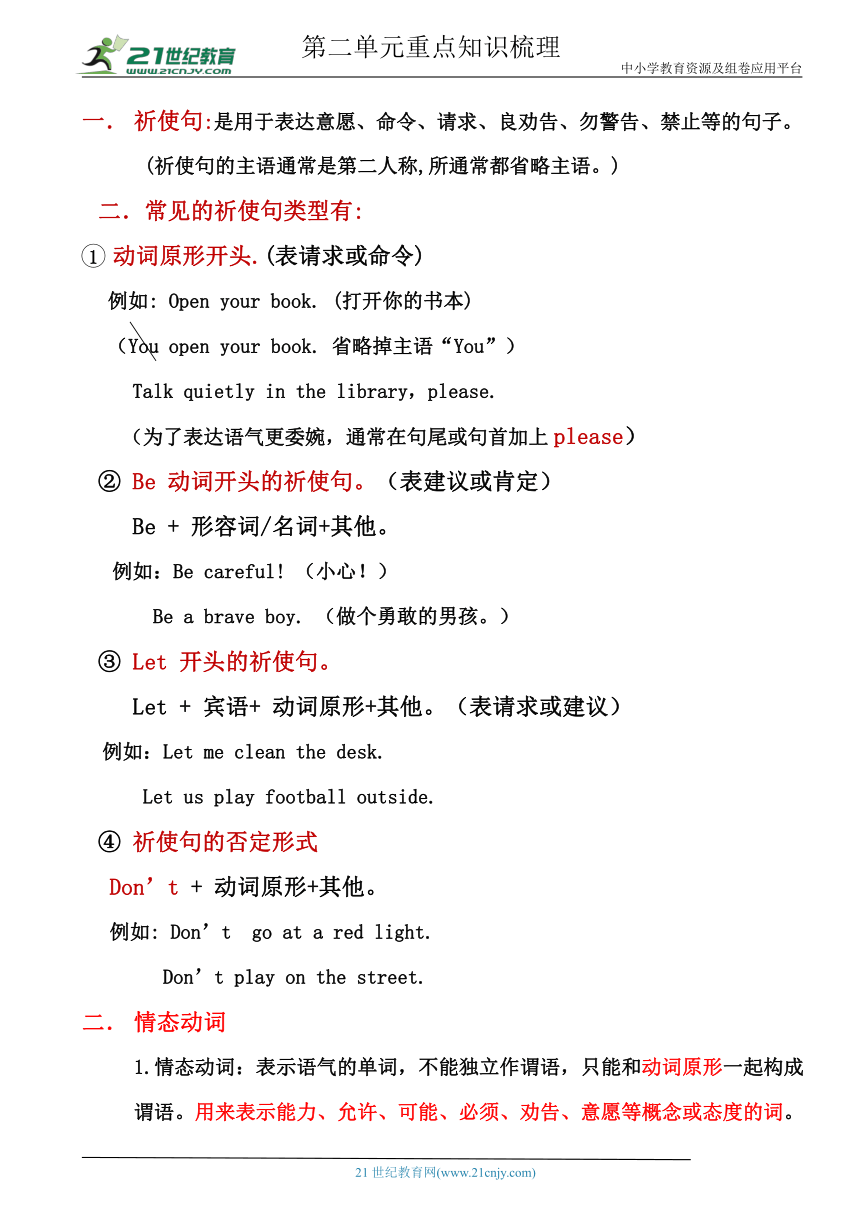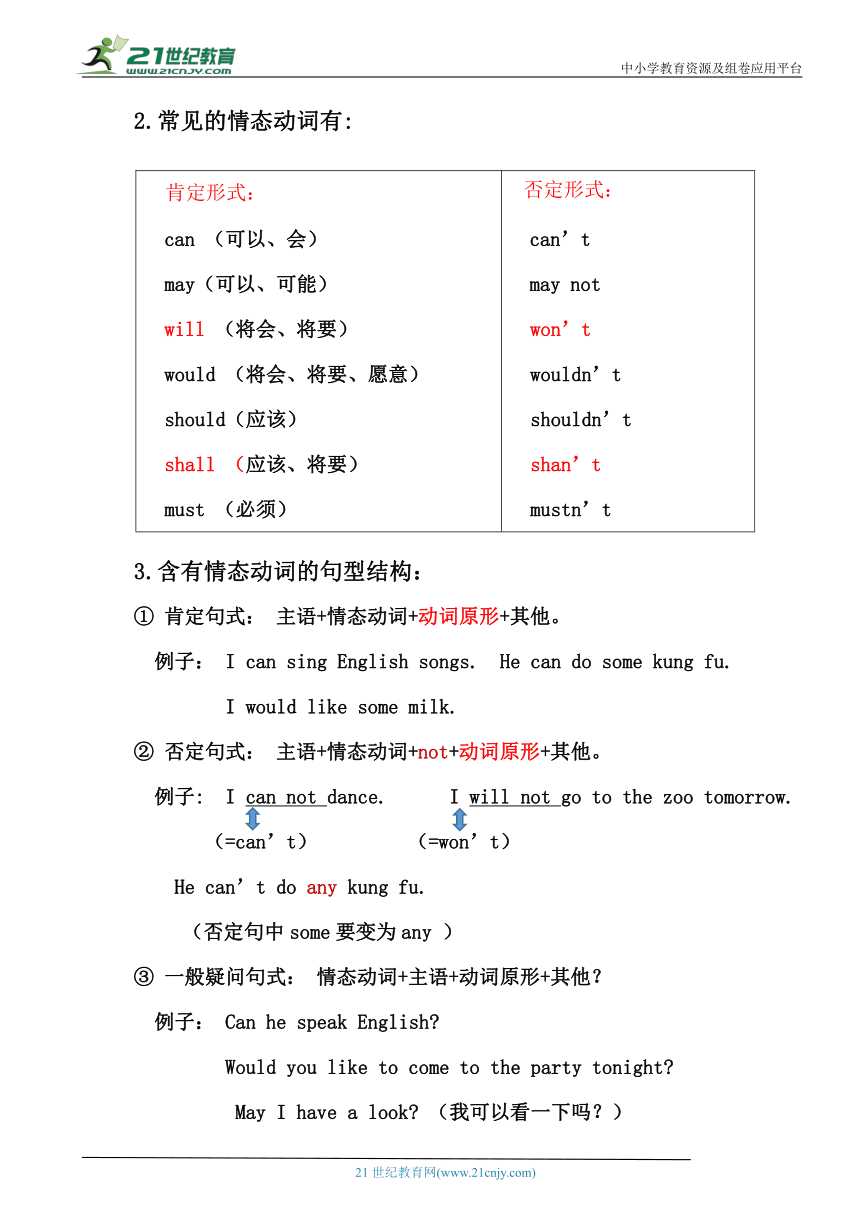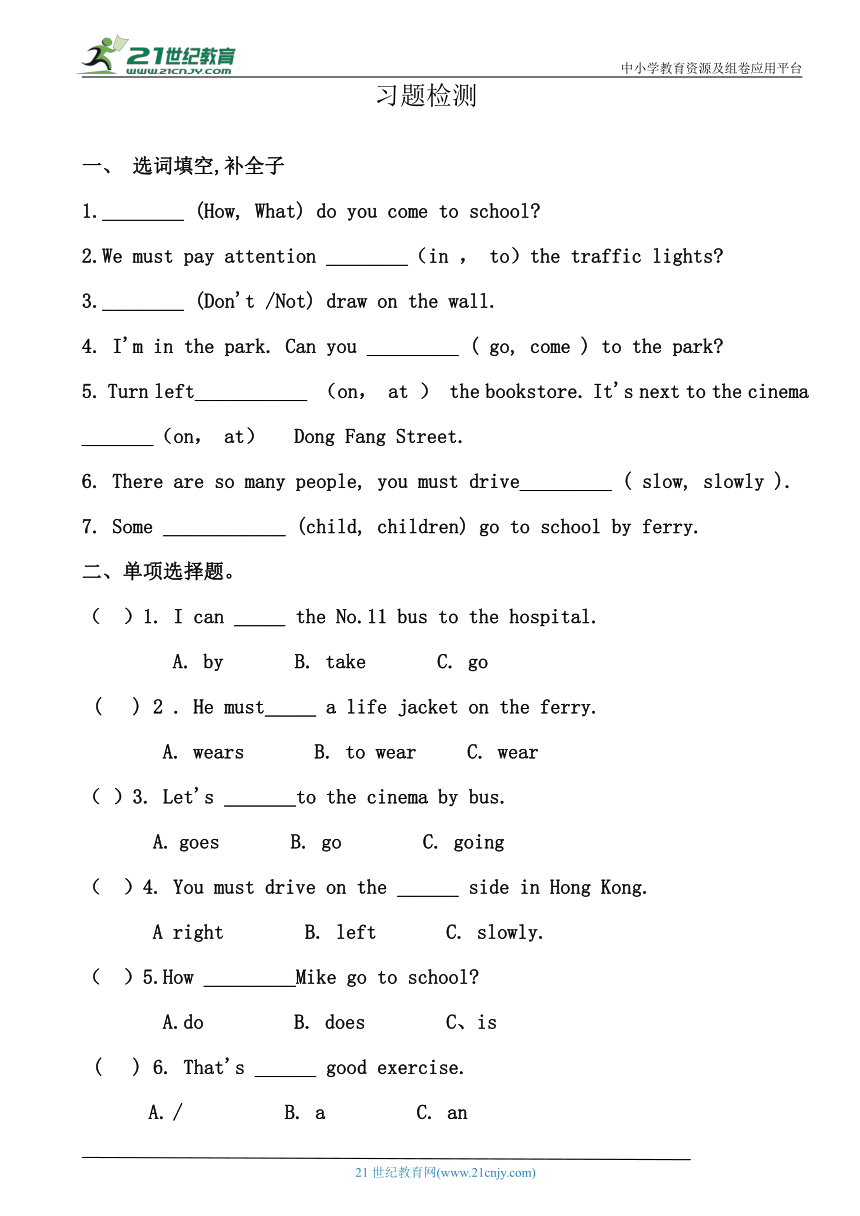unit 2 Ways to go to school 单元语法知识点+习题检测+单元参考范文(含答案)
文档属性
| 名称 | unit 2 Ways to go to school 单元语法知识点+习题检测+单元参考范文(含答案) |  | |
| 格式 | doc | ||
| 文件大小 | 1.2MB | ||
| 资源类型 | 试卷 | ||
| 版本资源 | 人教版(PEP) | ||
| 科目 | 英语 | ||
| 更新时间 | 2023-12-16 14:14:27 | ||
图片预览



文档简介
中小学教育资源及组卷应用平台
1. 祈使句:是用于表达意愿、命令、请求、良劝告、勿警告、禁止等的句子。
(祈使句的主语通常是第二人称,所通常都省略主语。)
二.常见的祈使句类型有:
1 动词原形开头.(表请求或命令)
例如: Open your book. (打开你的书本)
(You open your book. 省略掉主语“You”)
Talk quietly in the library,please.
(为了表达语气更委婉,通常在句尾或句首加上please)
② Be 动词开头的祈使句。(表建议或肯定)
Be + 形容词/名词+其他。
例如:Be careful! (小心!)
Be a brave boy. (做个勇敢的男孩。)
③ Let 开头的祈使句。
Let + 宾语+ 动词原形+其他。(表请求或建议)
例如:Let me clean the desk.
Let us play football outside.
④ 祈使句的否定形式
Don’t + 动词原形+其他。
例如: Don’t go at a red light.
Don’t play on the street.
2. 情态动词
1.情态动词:表示语气的单词,不能独立作谓语,只能和动词原形一起构成谓语。用来表示能力、允许、可能、必须、劝告、意愿等概念或态度的词。
2.常见的情态动词有:
can (可以、会)may(可以、可能) will (将会、将要)would (将会、将要、愿意) should(应该)shall (应该、将要) must (必须) can’t may not won’twouldn’tshouldn’tshan’tmustn’t
3.含有情态动词的句型结构:
① 肯定句式: 主语+情态动词+动词原形+其他。
例子: I can sing English songs. He can do some kung fu.
I would like some milk.
② 否定句式: 主语+情态动词+not+动词原形+其他。
例子: I can not dance. I will not go to the zoo tomorrow.
(=can’t) (=won’t)
He can’t do any kung fu.
(否定句中some要变为any )
③ 一般疑问句式: 情态动词+主语+动词原形+其他?
例子: Can he speak English
Would you like to come to the party tonight
May I have a look (我可以看一下吗?)
一、 选词填空,补全子
1.________ (How, What) do you come to school
2.We must pay attention ________(in , to)the traffic lights
3.________ (Don't /Not) draw on the wall.
4. I'm in the park. Can you _________ ( go, come ) to the park
5. Turn left___________ (on, at ) the bookstore. It's next to the cinema _______(on, at) Dong Fang Street.
6. There are so many people, you must drive_________ ( slow, slowly ).
7. Some ____________ (child, children) go to school by ferry.
二、单项选择题。
( )1. I can _____ the No.11 bus to the hospital.
A. by B. take C. go
( ) 2 . He must_____ a life jacket on the ferry.
A. wears B. to wear C. wear
( )3. Let's _______to the cinema by bus.
A. goes B. go C. going
( )4. You must drive on the ______ side in Hong Kong.
A right B. left C. slowly.
( )5.How _________Mike go to school
A.do B. does C、is
( ) 6. That's ______ good exercise.
A. / B. a C. an
( )7. How can we ________ there
A. get to B. go to C. get
( )8. In the USA people______ bikes must wear helmets.
A.at B. in C. on
( )9. _______ the children go to school by subway -No, they ______.
A. Are, aren’t B. Do, don’t C. Doe, doesn’t
( )10. What ______ interesting story!
A. / B. a C. an
( )11. Don’t ______ the dogs run too fast.
A. let B. lets C. Let’s
3. 按要求完成下列各题。
1. I go to school on foot. (就划线部分提问)
——————————————————————————————
2. The cinema is next to the bookstore. (就划线部分提问)
____________________________________________________________
3. We can take a bus to the science museum. (改为同义句)
——————————————————————————————
4. Ride the bike too fast. (改为否定句)
——————————————————————————————
5. take , bus , the , over , No.2 , there (.)(连词成句)
——————————————————————————————
单元习作范文
1. 写写你和家人是怎样去上学或上班的?
I am a pupil. I usually go to school by bike. Because I like riding my bike. Sometimes I go to school on foot. My father is a worker. He works far from home.
So he goes to work by car. My mother is a nurse. She usually goes to work on foot.
She thinks walking is good exercise.
2..假如你是Jack . 请根据表格提示,介绍你和你家人周末经常会去哪里,去干什么,怎样去的
Jack library read books on foot
Jack’s father park play sports by bike
Jack’s mother cinema see a film by car
I am Jack. I am a student. I don’t go to school on the weekend. So I usually to the library. I can read books there. It’s not far from my home. I go there on foot. My father likes playing sports. He often goes to the park by bike on the weekend. My mother likes to see a film on the weekend. She often goes to the cinema by car. What about your family
习题参考答案:
一、
1.How 2. to 3. Don't 4. come 5.at, on 6. slowly 7. children
二.
1. B 2.C 3.B 4 .B 5.B 6.A 7.C 8.C 9.B 10.C 11.A
三
1.How do you go to school
2. Where is the cinema
3.We can go to the science museum by bus.
4.Don't ride the bike too fast.
5.Take the No.2 bus over there.
第二单元重点知识梳理
否定形式:
肯定形式:
习题检测
21世纪教育网 www.21cnjy.com 精品试卷·第 2 页 (共 2 页)
HYPERLINK "http://21世纪教育网(www.21cnjy.com)
" 21世纪教育网(www.21cnjy.com)
1. 祈使句:是用于表达意愿、命令、请求、良劝告、勿警告、禁止等的句子。
(祈使句的主语通常是第二人称,所通常都省略主语。)
二.常见的祈使句类型有:
1 动词原形开头.(表请求或命令)
例如: Open your book. (打开你的书本)
(You open your book. 省略掉主语“You”)
Talk quietly in the library,please.
(为了表达语气更委婉,通常在句尾或句首加上please)
② Be 动词开头的祈使句。(表建议或肯定)
Be + 形容词/名词+其他。
例如:Be careful! (小心!)
Be a brave boy. (做个勇敢的男孩。)
③ Let 开头的祈使句。
Let + 宾语+ 动词原形+其他。(表请求或建议)
例如:Let me clean the desk.
Let us play football outside.
④ 祈使句的否定形式
Don’t + 动词原形+其他。
例如: Don’t go at a red light.
Don’t play on the street.
2. 情态动词
1.情态动词:表示语气的单词,不能独立作谓语,只能和动词原形一起构成谓语。用来表示能力、允许、可能、必须、劝告、意愿等概念或态度的词。
2.常见的情态动词有:
can (可以、会)may(可以、可能) will (将会、将要)would (将会、将要、愿意) should(应该)shall (应该、将要) must (必须) can’t may not won’twouldn’tshouldn’tshan’tmustn’t
3.含有情态动词的句型结构:
① 肯定句式: 主语+情态动词+动词原形+其他。
例子: I can sing English songs. He can do some kung fu.
I would like some milk.
② 否定句式: 主语+情态动词+not+动词原形+其他。
例子: I can not dance. I will not go to the zoo tomorrow.
(=can’t) (=won’t)
He can’t do any kung fu.
(否定句中some要变为any )
③ 一般疑问句式: 情态动词+主语+动词原形+其他?
例子: Can he speak English
Would you like to come to the party tonight
May I have a look (我可以看一下吗?)
一、 选词填空,补全子
1.________ (How, What) do you come to school
2.We must pay attention ________(in , to)the traffic lights
3.________ (Don't /Not) draw on the wall.
4. I'm in the park. Can you _________ ( go, come ) to the park
5. Turn left___________ (on, at ) the bookstore. It's next to the cinema _______(on, at) Dong Fang Street.
6. There are so many people, you must drive_________ ( slow, slowly ).
7. Some ____________ (child, children) go to school by ferry.
二、单项选择题。
( )1. I can _____ the No.11 bus to the hospital.
A. by B. take C. go
( ) 2 . He must_____ a life jacket on the ferry.
A. wears B. to wear C. wear
( )3. Let's _______to the cinema by bus.
A. goes B. go C. going
( )4. You must drive on the ______ side in Hong Kong.
A right B. left C. slowly.
( )5.How _________Mike go to school
A.do B. does C、is
( ) 6. That's ______ good exercise.
A. / B. a C. an
( )7. How can we ________ there
A. get to B. go to C. get
( )8. In the USA people______ bikes must wear helmets.
A.at B. in C. on
( )9. _______ the children go to school by subway -No, they ______.
A. Are, aren’t B. Do, don’t C. Doe, doesn’t
( )10. What ______ interesting story!
A. / B. a C. an
( )11. Don’t ______ the dogs run too fast.
A. let B. lets C. Let’s
3. 按要求完成下列各题。
1. I go to school on foot. (就划线部分提问)
——————————————————————————————
2. The cinema is next to the bookstore. (就划线部分提问)
____________________________________________________________
3. We can take a bus to the science museum. (改为同义句)
——————————————————————————————
4. Ride the bike too fast. (改为否定句)
——————————————————————————————
5. take , bus , the , over , No.2 , there (.)(连词成句)
——————————————————————————————
单元习作范文
1. 写写你和家人是怎样去上学或上班的?
I am a pupil. I usually go to school by bike. Because I like riding my bike. Sometimes I go to school on foot. My father is a worker. He works far from home.
So he goes to work by car. My mother is a nurse. She usually goes to work on foot.
She thinks walking is good exercise.
2..假如你是Jack . 请根据表格提示,介绍你和你家人周末经常会去哪里,去干什么,怎样去的
Jack library read books on foot
Jack’s father park play sports by bike
Jack’s mother cinema see a film by car
I am Jack. I am a student. I don’t go to school on the weekend. So I usually to the library. I can read books there. It’s not far from my home. I go there on foot. My father likes playing sports. He often goes to the park by bike on the weekend. My mother likes to see a film on the weekend. She often goes to the cinema by car. What about your family
习题参考答案:
一、
1.How 2. to 3. Don't 4. come 5.at, on 6. slowly 7. children
二.
1. B 2.C 3.B 4 .B 5.B 6.A 7.C 8.C 9.B 10.C 11.A
三
1.How do you go to school
2. Where is the cinema
3.We can go to the science museum by bus.
4.Don't ride the bike too fast.
5.Take the No.2 bus over there.
第二单元重点知识梳理
否定形式:
肯定形式:
习题检测
21世纪教育网 www.21cnjy.com 精品试卷·第 2 页 (共 2 页)
HYPERLINK "http://21世纪教育网(www.21cnjy.com)
" 21世纪教育网(www.21cnjy.com)
同课章节目录
